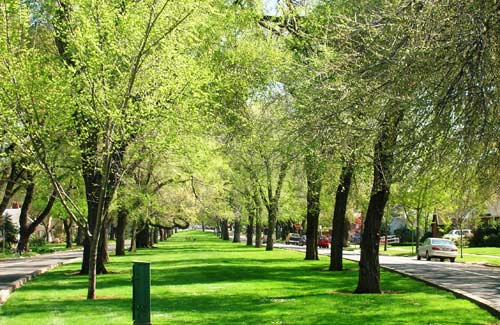By Deanne Buckman, Policy Intern
Certain things come to mind when we think about crime prevention: police squads, guard dogs, community watch groups. However, according to multiple studies, we should possibly also think of trees.
As a criminology student and an intern at American Forests, I was intrigued when I discovered this connection between my two areas of interest. After a little research on the topic, I found that certain theories of community crime proved helpful in understanding the relationship.

Routine activity theory — — suggests that if characteristics of a neighborhood decrease the chance of a crime being observed, then they increase the chance of the crime occurring, and vice versa. Therefore, if trees reduce the probability that a criminal would be observed, they would increase the probability of crime; in fact, urban vegetation removal has been used in the past as a crime reduction strategy.
However, evidence now suggests that strategically planted vegetation in under-privileged communities may actually reduce crime by drawing people to public places and increasing the probability of a criminal being observed. Researchers Geoffrey Donovan and Jeffrey Prestemon (2012) found that larger trees are generally less view-obstructing than smaller trees because views are mainly obstructed by the canopy of the tree, and larger trees have higher canopies.
Certain characteristics make some communities more crime prone than others. These include: low economic status, high inequality, dense or overcrowded populations, and high population mobility (Agnew, 1999). These factors can cause strain and mental fatigue, while nature has been found to be able to calm people, decrease irritability and enhance mental functioning (Sullivan et al., 2004).
According to the defensible space and broken windows theories, criminals use the appearance of a community to determine if it is defended by its members and judge the probability of being caught in the criminal act. The physical design of an area can influence people’s use of the space, which influences both the control the residents have over the area and the effort they dedicate to its maintenance (Gau and Pratt, 2008).
In a study by William Sullivan et al. (2004), a sample of 59 outdoor spaces with varying degrees of vegetation were selected from a single residential area. After observing use of the spaces, researchers concluded there were always more people in the greener spaces, as well as larger groups of people interacting with one another. By drawing residents into the spaces immediately outside their homes, vegetation could promote neighborly interactions, creating stronger community ties and a greater sense of stewardship. Trees may also help to deter crime if they help a neighborhood appear well maintained, since poorly maintained neighborhoods appear to be poorly defended.
Despite how promising all of this sounds in theory, further research has shown that urban forests may actually produce the opposite of the desired effect without careful planning and maintenance. There is still much that needs to be understood about the effects of trees in urban settings and the best ways to implement them.
Stay tuned for the second part of our urban forests and crime posts, coming on Monday, June 22!
Sources cited:
- Agnew, Robert. A General Strain Theory of Community Differences in Crime Rates. Journal of Research in Crime and Delinquency. Vol. 36, 2. May 1999. P. 123-155.
- Donovan, Geoffrey and Jeffrey Prestemon. The Effect of Trees on Crime in Portland Oregon. Environment and Behavior. Vol 44, 1. P. 3-30.
- Gau, Jacinta, and Travis Pratt. “Broken Windows or Window Dressing? Citizens’ (In)Ability To Tell The Difference Between Disorder And Crime.” Criminology & Public Policy Vol 7.2. 2008. P. 163-94.
- Sullivan, William, et al. The Fruit of Urban Nature. Environment and Behavior. Vol 36, 5. September 2004. P. 678-700.